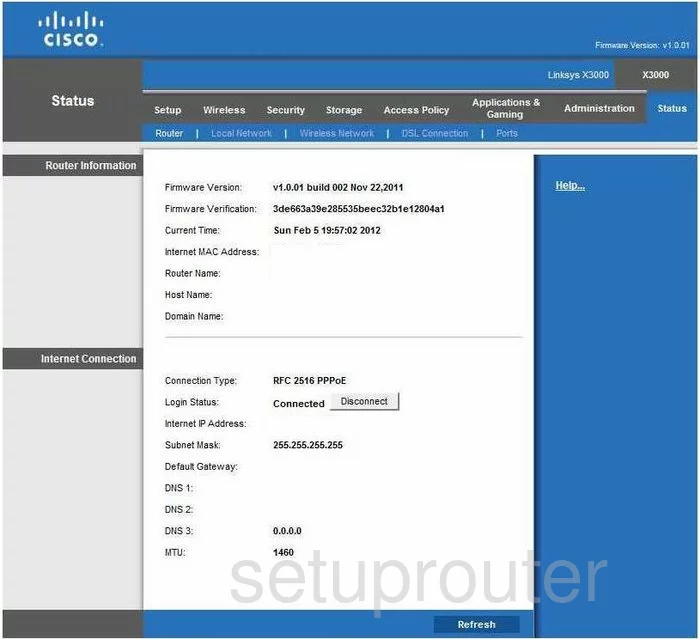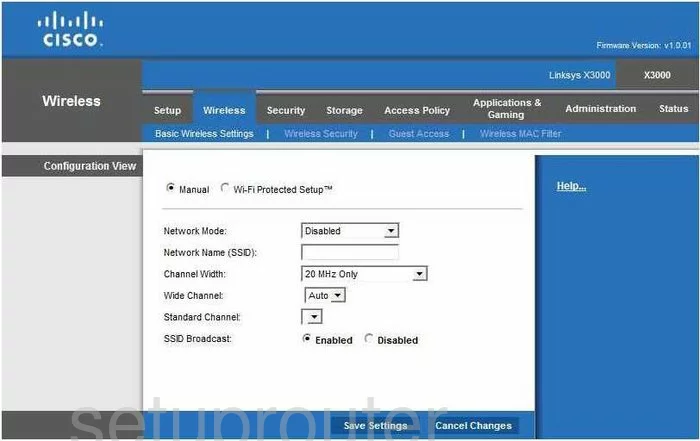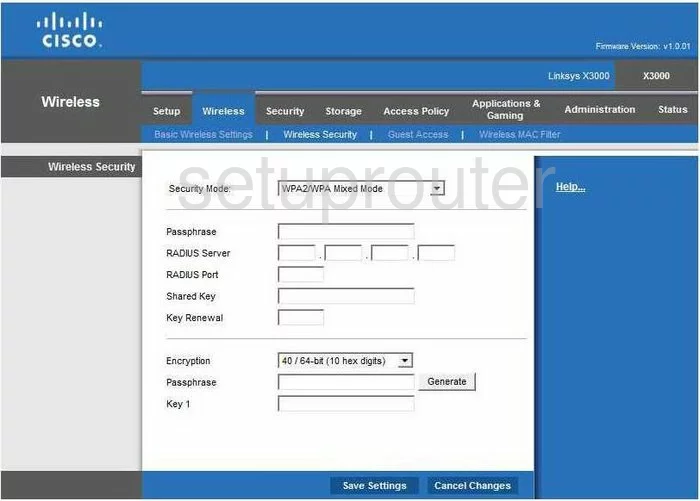The Cisco X3000 router is considered a wireless router because it offers WiFi connectivity. WiFi, or simply wireless, allows you to connect various devices to your router, such as wireless printers, smart televisions, and WiFi enabled smartphones.
Other Cisco X3000 Guides
This is the wifi guide for the Cisco X3000. We also have the following guides for the same router:
WiFi Terms
Before we get started there is a little bit of background info that you should be familiar with.
Wireless Name
Your wireless network needs to have a name to uniquely identify it from other wireless networks. If you are not sure what this means we have a guide explaining what a wireless name is that you can read for more information.
Wireless Password
An important part of securing your wireless network is choosing a strong password.
Wireless Channel
Picking a WiFi channel is not always a simple task. Be sure to read about WiFi channels before making the choice.
Encryption
You should almost definitely pick WPA2 for your networks encryption. If you are unsure, be sure to read our WEP vs WPA guide first.
Login To The Cisco X3000
To get started configuring the Cisco X3000 WiFi settings you need to login to your router. If you are already logged in you can skip this step.
To login to the Cisco X3000, follow our Cisco X3000 Login Guide.
Find the WiFi Settings on the Cisco X3000
If you followed our login guide above then you should see this screen.

Starting on the Router Status page, click the link at the the top of the page labeled Wireless. Then, below that in the blue bar, click Basic Wireless Settings.
Change the WiFi Settings on the Cisco X3000

- Configuration View - Choose the option of Manual. We strongly advise against using WPS or Wi-Fi Protected Setup. This is very insecure option. To learn more, read our guide titled What is WPS.
- Network Mode - This is asking the age of the devices you are using to connect to the internet. Most of us use a range of devices so go ahead and click Mixed.
- Network Name (SSID) - This is the name you give your network so you can identify it later on. When creating this name, don't use any personal information. To learn more about this, read our Wireless names guide.
- Wide Channel - Leave this at the default setting.
- Standard Channel - There is only room in the wireless spectrum for up to three channels that don't overlap one another. Overlapping channels causes a lot of interference. Be sure you are on one of the non-overlapping channels, 1,6, or 11. To learn more about this, read our WiFi Channels guide.
- SSID Broadcast - If you want to hide your network name from your neighbors, click the option of Disabled. This does not mean your network is completely invisible, just camouflaged. A hacker can still find your network if they really want to.
- Save Settings - Tick this button when you are finished on this page.
Now, click Wireless Security at the top of the page, in blue.

- Security Mode - Use this drop down list to choose WPA2 Personal. To learn why this is the best option available, check out our guide titled WEP vs. WPA.
- Passphrase - This is the password you use to access your local network. A strong password doesn't contain any personal information. It does not use any words that can be found in a dictionary. It does contain at least 20 characters, and at least one symbol, capital letter, and number. To learn more about this topic, tick the link titled Choosing a strong password.
- Save Settings - Congratulations, you did it.
Possible Problems when Changing your WiFi Settings
After making these changes to your router you will almost definitely have to reconnect any previously connected devices. This is usually done at the device itself and not at your computer.
Other Cisco X3000 Info
Don't forget about our other Cisco X3000 info that you might be interested in.
This is the wifi guide for the Cisco X3000. We also have the following guides for the same router: